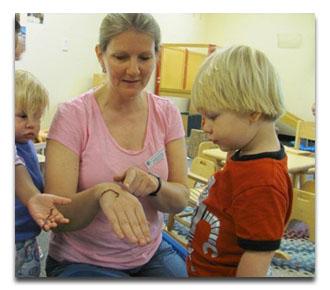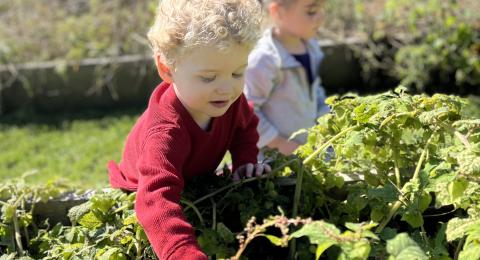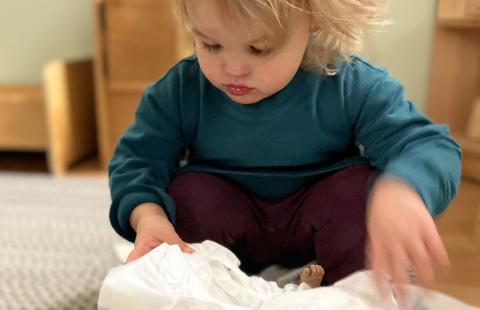The Toddler Room has 12 children between the ages of 18- to 33-months old at the beginning of each school year with three full-time classroom teachers.
Toddler Classroom Handbook
Teachers will provide you with a Toddler Classroom Handbook before your child starts their enrollment to share information about the philosophy, curriculum, and practices of the program. This will also contain information about the things your child should have at school, school policies, and the daily schedule of the Toddler Classroom.
Classroom Teachers
Toddler Room Daily Schedule
7:30 The center opens
7:30 – 9:00 Arrival and free play
8:30 – 9:00 Snack time
9:00 – 9:30 Explorations & investigations
9:30 – 9:45 Cleanup & transition activity (story or movement activity)
9:45 -11:15 Outdoor exploration & playground time
11:15-11:30 Circle Time (books, singing, dancing)
11:30-12:00 Lunch
12:00-12:15 Lunch, clean-up, story-time
12:15 - 3:00 Nap (music & wave machine)
2:00 – 3:15 Wake up/free play/snack
3:15 – 3:30 Clean-up and transition activity
3:30 – 5:20 Outdoor time (weather permitting)/gross-motor
5:20 Linking space; last pick-up
5:25 Keypad for entry code will be locked
5:30 The center closes
The above schedule gives you an idea of a typical day in the toddler classroom. It may change slightly throughout the year due to the weather and the developmental needs of the children. Diapering and toileting will take place every two hours or as needed.
Toddler Room
Foundation, Framework, & Intentions 2021-2022

As a Reggio-Emilia inspired school, CSDC practices emergent curriculum while providing children with developmentally appropriate experiences and challenges. Through observing, analyzing, documenting, and photographing children’s play, social interactions, and work, we can further plan and develop our classroom curriculum based on the children’s abilities and interests. In addition to this, we have an imbedded curriculum that serves as the foundation, framework, and intentions of our program and community, which include Exploring Artistic Mediums; Self-Identity & Emotions; Developing Relationships & Building Community; Autonomy & Capability; Exploring & Respecting Our Natural Environment; Building & Constructing Knowledge; and Emergent Literacy.
Autonomy & Capability
As teachers, we believe that autonomy and capability go hand in hand. Children are provided with materials on shelves they can access and choose from freely. In the Toddler Room, we see children as contributing members of our community. Children are recognizing that they have skills and competencies that are valuable and are working to gain independence in accomplishing tasks and goals. As teachers, we often use children who are experts in a skill to share their knowledge with other children.
Building & Constructing Knowledge
We view learning as a process or a journey. Through inquiry, hypothesizing, predicting, and developing theories, children can make discoveries and come to conclusions about the world around them within various contexts. By providing ample wait time, children can build and construct knowledge through problem-solving, trial and error, cause and effect, and persistence.
Emergent Literacy
Foundations for literacy development are implemented daily in our curriculum. From choosing song cards at circle time, to using visual recipes while cooking, to recognizing the letter of their first name, children are using visuals every day to gain information and share information. Through looking at books and storytelling, children use photos as contextual clues to make predictions about what will happen next or to recall events in the story. Children in the toddler room vary in age, and therefore, vary in literacy experience; some may be exploring literacy tools as simple objects, while others see and understand that literacy tools share information and have meaning.
Exploring Artistic Mediums
Through paint, glue, writing implements, and various other mediums, toddlers have the opportunity to explore art freely and without constraint. Teachers may provide opportunities for children to experiment with working on projects individually as well as collaboratively. We value artistic expression as an important language of the children.
Exploring & Respecting Our Natural Environment
We often think of the outdoors as an extension of our classroom. With access to the garden, the woods, the nature trail, and beyond, there are vast opportunities for exploration. We strive to encourage children to explore and engage with the natural world and teach them to respect the animals and insects that live in this habitat through close and gentle observation. In the Toddler Room, we place a high level of importance on sustainability and incorporate efforts through reusing and recycling materials as well as thinking about the materials we use for exploration in this realm.
Developing Relationships & Building Community
Our classroom community encompasses a variety of relationships in a child’s life: child to child, child to teacher, child to families, child to interns, child to teaching assistants. Because of the proximity in both classroom location and developmental experiences, we extend our classroom community to encompass the Infant Room and the wider school community, allowing for opportunities for cross-classroom collaboration to take place.
Self-Identity & Emotions
Children in the Toddler Room are at an age where they are recognizing their sense of self as well as their sense of others. Through self-advocacy, conflict resolution, and recognizing emotions, toddlers are learning about their own needs. Through empathy, perspective taking, and communication, toddlers are learning about the needs of others. Through literacy, photographs, and life experiences, toddlers are noticing their own physical characteristics along with the physical characteristics of their peers and recognizing the diversity within their community.
Toddler Room Vision & Mission Statement
Vision Statement
All children have the right to:

- A safe and nurturing environment.
- Develop caring and trusting relationships with teachers.
- Build a respectful community that encompasses their families, peers, and teachers.
- Curriculum that is developmentally appropriate, child-initiated, and emergent.
- Engage in a routine that is predictable, consistent, and flexible.
- Participate in opportunities that allow them to explore freely.
Mission Statement
As teachers in the Toddler Room, our mission is to create an environment where children and families feel safe, secure, represented, and respected. Through careful observation, we develop an emergent curriculum that supports children's capabilities and autonomy to help them reach their full potential.
Core Values and Beliefs
- Autonomy and Capability – recognizing children’s growing autonomy and capabilities by offering opportunities for them to build upon them; for example, placing materials on shelves within children’s reach, and not putting children in positions they can’t get into themselves (i.e.: not placing them on a tall stump they can’t climb onto themselves).
- Communication – children communicate their thoughts, ideas, wants, and needs through various methods, which include tone of voice, body language, facial expressions, signing, and verbal language. In order to give every child a voice, regardless of their verbal abilities, we support children to begin to interpret and recognize these various methods of communication.
- Conflict Resolution – taking the time to assess the situation and listen to all sides while allowing children to work through conflict. We encourage children to use language that they know, see things from another child’s perspective, and to develop solutions to the conflict that addresses all children’s needs.
- Emotions – children recognizing their emotions as well as those of their peers. Teachers support this by introducing vocabulary that encompasses a variety of feelings (excited, frustrated, scared, silly, jealous, etc.).
- Problem Solving – encouraging children to develop strategies and skills to accomplish tasks and come to conclusions with the support of a teacher if needed.
- Wait Time - giving children the time and opportunity to freely explore, experiment, and make discoveries in order to come to their own realizations and conclusions about the world around them.



